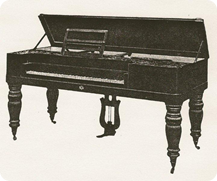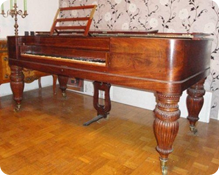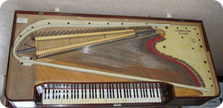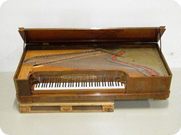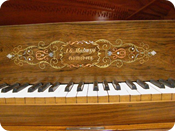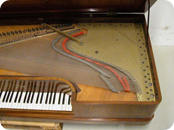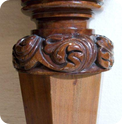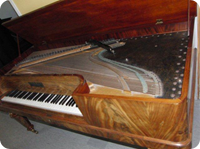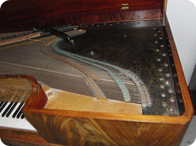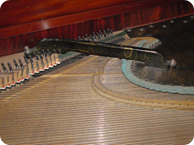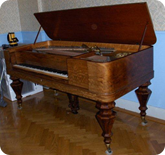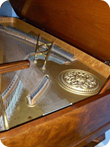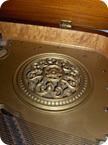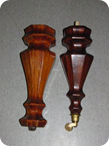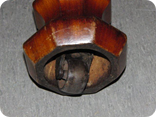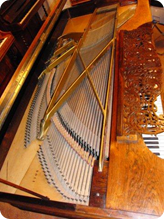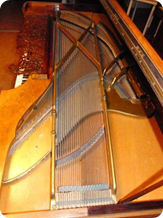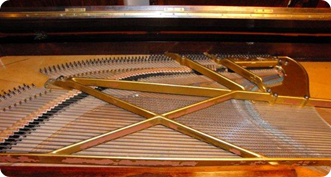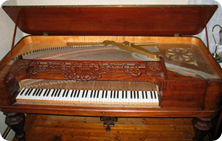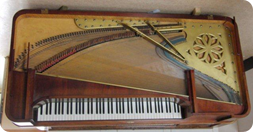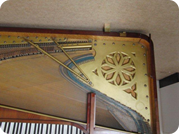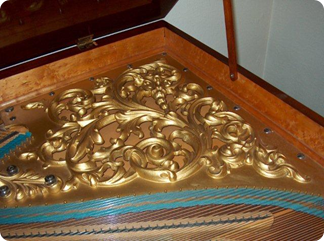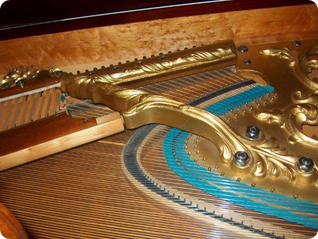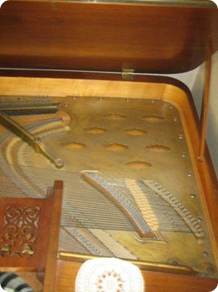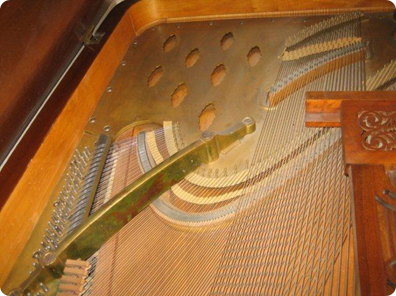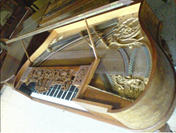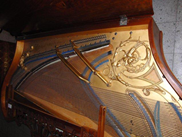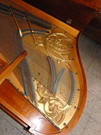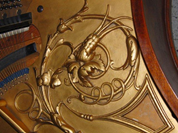We are still working with this site. Plaese, check the changes regularly. 
Ändra den här texten genom att klicka på "Redigera" |
J.G. Malmsjös taffelmodeller
Johan Gustaf Malmsjö started his production in Gothenburg in 1843/44 with square pianos which the factory built until c. 1890 in several models and various design. Below, there is a first overview of square pianos from the Malmsjö factory based on the construction of the iron frame. The model names used here are also found in the lists of Malmsjö instruments in our collections.
Model no. 1 was taken over from Malmsjö’s master Olof Berndt Ekström in Malmö. Malmsjö brought two such square pianos that served as initial capital when he moved to Gothenburg in the autumn 1843. No. 1 was sold to the Free Masons restaurateur Dahlström on 22nd of December 1843 for a sum of 650 thaler. No. 2 was bought by the Gothenburg bishop Anders Brun (1778-1856) for the same price on 8th of January 1844. It was not until April this year that Malmsjö was provided with what he needed to start his own production, and on 28th of August he sold his first Gothenburg built square piano. We have only hints how it may have looked.
Malmsjö’s opus 1 was a construction by the piano maker O.B. Ekström in Malmö (destroyed when the Gothenburg Concert Hall burnt in 1928; left). Square piano no. 2 was most probably made in the same way, probably mirrored by an instrument by Ekström in the KH collections. KH 500 (middle, right). |
A square piano by Malmsjö with a beautiful name board is dated to the 1840s. The weak treble iron bar and the carvings on the upper part of the legs tell that it is made early in the production of this factory. MTM X5618. Photo: MTM |
The factory improved production efficiency latest in 1852 when the carvings on the upper part of the legs were replaced by such ones that were less complicated to make, the weak treble iron bar became stronger and fixed to a wrought iron hitch-pin plate, sometimes gilt speckled like in this square piano with serial no. 472 from 1855. KH 78. |
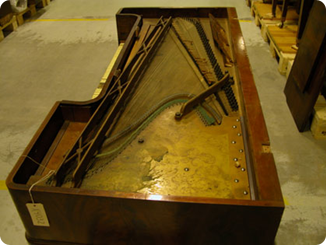 |
The black wrought iron hitch-pin plate model was kept by Malmsjö in the greater part of the 1850s. At the end of this decade other ideas on instrument making manifested themselves, introduced by Ch. H. Billberg, a worker with Malmsjö who had been in America in 1854-1859 and was his partner in 1859-1864. The first known example of the new thoughts is a square piano model with two bass cast iron bars which are in principle parallel and connected to each other in four X-formed sections (‘connected X-iron bars’) and combined to a wrought iron hitch-pin plate of the same shape as the black one (the same scaling) and one treble cast iron bar. A square piano with serial no. 802 from 1859 has this construction. MTM X 4032. Photo: MTM. |
| From 1859 to around 1880 Malmsjö produced a series of square pianos of American type. We call one of these models ‘circle’ because of the cupola shaped elevation of the cast iron hitch-pin plate which is a copy of an instrument by Chickering & Sons, made in the 1840s. Billberg worked with Chickering in the 1850s, and it cannot be excluded that his employer allowed him to take over a model that was no longer in production. In Swedish production we, for the first time, find a cast iron hitch-pin plate with two treble cast iron bars that are joined and supported by two semi-circles. The cross-stringing was another new feature of construction. The photos show the square piano serial no. 853 from 1859 with covered wheels as is customary with American instruments. With us these were soon changed to normal construction with free wheels. The model was built until c. 1870. The pictures of the cast iron hitch-pin plate represent the square piano serial no. 1245 from 1862 (KH 252), the covered wheels serial no. 853 from 1859. KH 478. |
The largest known Malmsjö square piano model till now is a whopper, 2.10 meters in length and 1 meter in width, and serial no. 1706 from 1866. The instrument has a globe shaped bottom serving an extra soundboard. The frame construction, which is unique in the Malmsjö production, is a development of the ‘connected X-iron bars frame’ having one larger X-section, two treble iron bars and pressure bar (‘big X-frame’). Some features such as the rarely found construction, the music stand with extremely rich fretwork and the backside allowing the instrument to stand freely, make probable that the instrument is an exhibition square piano shown at the Stockholm General Industrial fair in 1866. The instrument is, as far as we know, unique. KH 552 |
| In the middle of the 1860s Malmsjö also made oblique strung square pianos. We know of two models of which one is inspired by American constructions with a hitch-pin iron plate and clear features lent from the Chickering factory (‘rose model’). The treble bar is double V-shaped, a system that is also to be found in early grand pianos by Malmsjö, pressure bar and a long bass bar. The model is known between 1864 and 1868. It is not too common and has probably not been made in great numbers. Photos display no. 1530 from 1864. KH 499. |
The other oblique strung square piano model made in the 1860s is the ‘acanthus’ model, so called because of the rich décor of leaf runners that ornate the cast iron hitch-pin plate. There is a solid treble cast iron bar and a pressure bar. The model is known around the middle of the 1860s and is, like the ’rose model’, rather uncommon. The square piano no. 1706 from 1866 (double-numbered with KH 552 having the ’large X-frame’, see above). Private ownership. |
From the 1870s to c. 1881 Malmsjö built his maybe most common square piano model that is clearly influenced by American piano making, nearest from the Steinway factory in New York. We call it the ‘leaf model’ because of the shape of the sound holes in the cast iron hitch-pin plate, which are also found in grand piano models of the Malmsjö factory from the same period. The construction has a solid treble bar and a long, partly hidden bass bar. The model is cross strung. Photos of instrument no. 3319 from 1876. Private ownership. Photo: Odd Aanstad. |
| The latest of the Malmsjö square piano models which was made in the 1880s is the cornice. It is not table-shaped but has bending sides to augment the size of the soundboard so that the bass bridge is not placed too narrow to the rim (for better resonance). The model is cross strung. The iron frame is not made in one casting but screwed together. Photos of no. 4559 från 1885. KH 106. |
|
|


